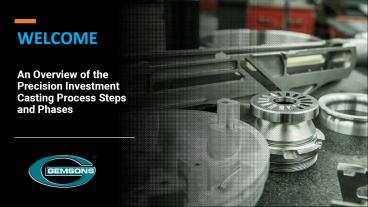An Overview of the Precision Investment Casting Process Steps and Phases | GEMSONS - PowerPoint PPT Presentation
Title:
An Overview of the Precision Investment Casting Process Steps and Phases | GEMSONS
Description:
Investment castings are made using a method called investment casting. The process begins with the creation of the master pattern. To create the one-of-a-kind pattern, the artist could use wax, clay, steel, plastic, or wood. He'll be able to make the mould or master die after that. Investment Castings – PowerPoint PPT presentation
Number of Views:37
Title: An Overview of the Precision Investment Casting Process Steps and Phases | GEMSONS
1
WELCOME
- An Overview of the Precision Investment Casting
Process Steps and Phases
2
Introduction
- One of the oldest methods of making metal
precision components is investment casting. The
process starts with the creation of a wax
pattern, which is a steel replica of the required
component. - The design is encased in a ceramic material,
which is then heated to remove it. After that,
molten steel will be poured into the mold's
opening. After the solid steel mould has been
ripped away, the casting is ready to use. - Investment castings are made using a method
called investment casting. - The process begins with the creation of the
master pattern. To create the one-of-a-kind
pattern, the artist could use wax, clay, steel,
plastic, or wood. He'll be able to make the mould
or master die after that. - This one is made of metal, steel, or metal. The
steps and phases of investment casting are listed
below.
3
STEPS INVOLVED IN INVESTMENT CASTING
- TOOLING
- Dies are made by skilled tool room technicians
using CNC machining and EDM procedures. - The majority of investment tools are composed of
aluminum and have brass or steel cores as well as
retractable slides. - INJECTION OF WAX PATTERN
- To ensure dimensional homogeneity, liquid pattern
wax is injected under temperature/pressure
controlled conditions from the first to the
hundredth injection cycle. - When the wax construction has set, it can be
readily removed from the die. - ASSEMBLING THE STRUCTURE
- After that, the wax drawings are attached to a
wax runner system, which allows the molten metal
to flow freely. - Using over 30 basic designs of runners, castings
of varied sizes and sections can be built to a
high degree of precision.
4
Continue
- Making Molds
- Following the completion and cleaning of the wax
assemblies, a ceramic shell is constructed by
repeatedly dipping the wax assembly in a liquid
ceramic slurry and then coating it with ceramic
stucco. - The shell-making robot technology used to invest
the assemblies is completely automated. The
investment shell is built up in stages until it
reaches a thickness that is thick enough to
withstand the pouring's thermal stresses. - De-Waxing
- The wax is steamed away from the investment shell
in a steam pressure vessel, leaving the negative
hollow spaces of the components within. - Fire the Mould
- To remove wax residue, boost mechanical strength,
and preheat in preparation for the casting
process, Ceramic Shell moulds are burned at
1000C.
5
Continue
- Coating of Shells
- In Shell coating, the pattern assembly will be
dipped in a ceramic slurry and coated with a
refractory material. - Rep this process until the desired thickness and
strength are achieved. After that, the ceramic
shell is finished and placed in an
atmosphere-controlled chamber to dry. - Finishing
- After the metal has been set, the ceramic mould
is removed and cleaned with pneumatic vibratory
machinery. - In preparation for heat treatment or quality
assurance, the castings are cut away from the
runner, fettled, and shot blasted. - Treatment with Heat
- As cast constructions, castings are heat-treated
to improve mechanical characteristics,
machinability, and homogeneity. - Heat treatment is carried out on-site in
atmosphere-controlled furnaces.
6
Conclusion
- In the power generation and aerospace industries,
investment castings are widely employed. - They're utilized to make intricate structures for
turbine blades and cooling systems, among other
things. Blades that are directionally solidified,
generally equated, and single-crystal are among
the most common blades produced by the process. - Military, medical, automotive, and commercial
applications all require investment castings.































